
|
Now it is 7.3 mag (May 14, Marco Goiato). It will pass close to the earth from spring to summer, and it is expected to brighten up to 6 mag. In the Southern Hemisphere, it keeps observable in excellent condition after this. In the Northern Hemisphere, it locates low in the south.
Date(TT) R.A. (2000) Decl. Delta r Elong. m1 Best Time(A, h)
May 21 23 9.99 -9 20.4 1.243 1.390 75 6.9 3:12 (295, 18)
May 28 22 56.10 -13 53.8 1.060 1.427 86 6.7 3:06 (305, 21)
|

|
It passed only 0.036 a.u. from the earth on Mar. 21-22, and brightened up to 3.9 mag (Mar. 21, Thomas Lehmann). It kept brightening even after the perihelion passage. However, it is fading now. It has already faded down to 9.1 mag (May 20, Thomas Lehmann). It keeps observable in excellent condition for a while after this both in the Northern Hemisphere and Southern Hemisphere. It may fade out very rapidly.
Date(TT) R.A. (2000) Decl. Delta r Elong. m1 Best Time(A, h)
May 21 16 55.97 8 25.6 0.376 1.344 147 9.3 1:02 ( 0, 63)
May 28 16 49.16 7 29.6 0.430 1.403 150 10.2 0:27 ( 0, 63)
|

|
Now it is 10.2 mag (May 15, Juan Jose Gonzalez). It will be fading slowly after this. It is observable in excellent condition in the Northern Hemisphere. It is observable in the evening sky also in the Southern Hemisphere until August.
Date(TT) R.A. (2000) Decl. Delta r Elong. m1 Best Time(A, h)
May 21 10 58.54 39 41.5 2.637 2.812 89 10.7 20:41 (110, 70)
May 28 11 0.08 36 37.9 2.769 2.863 84 10.9 20:48 (103, 63)
|

|
Now it is 11.2 mag (May 10, Thomas Lehmann). It keeps 11 mag until summer. In the Northern Hemisphere, it will be getting lower after this, and will be unobservable in June. It locates somewhat low in the Southern Hemisphere, but it keeps observable until August.
Date(TT) R.A. (2000) Decl. Delta r Elong. m1 Best Time(A, h)
May 21 7 43.72 21 36.5 2.088 1.700 53 11.8 20:41 ( 99, 25)
May 28 8 2.05 20 57.2 2.111 1.678 51 11.7 20:48 (101, 22)
|

|
Now it is 13.6 mag (May 7, Jakub Cerny). Brightening very rapidly, but it is fainter than this ephemeris. It is expected to be observable at 11 mag in good condition until summer.
Date(TT) R.A. (2000) Decl. Delta r Elong. m1 Best Time(A, h)
May 21 11 44.93 14 26.0 1.062 1.700 110 11.9 20:41 ( 34, 66)
May 28 11 50.04 12 31.2 1.088 1.674 105 11.8 20:48 ( 45, 60)
|
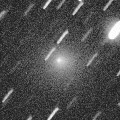
|
Now it is very bright as 11.5 mag (May 8, Jakub Cerny). In the Northern Hemisphere, it is observable at 12 mag in excellent condition until June. It locates very low in the Southern Hemisphere.
Date(TT) R.A. (2000) Decl. Delta r Elong. m1 Best Time(A, h)
May 21 22 33.83 40 36.0 1.481 1.469 69 12.0 3:12 (246, 49)
May 28 22 5.72 44 57.6 1.356 1.506 77 12.1 3:06 (240, 58)
|

|
Now it is 12.2 mag (May 2, Seiichi Yoshida). It keeps 12-13 mag for a long time from 2015 autumn to 2016 summer. In the Northern Hemispehre, it keeps observable in good condition for a long time. It keeps unobservable until July in the Southern Hemisphere.
Date(TT) R.A. (2000) Decl. Delta r Elong. m1 Best Time(A, h)
May 21 17 25.88 71 23.8 2.636 2.773 86 12.3 1:32 (180, 54)
May 28 16 52.21 69 53.8 2.631 2.794 88 12.3 0:31 (180, 55)
|

|
Now it is 11.9 mag (May 4, Seiichi Yoshida). It brightened up to 6 mag from autumn to winter. Now it is fading. It is not observable after this in the Southern Hemisphere. It will be extremely low from May to June also in the Northern Hemisphere.
Date(TT) R.A. (2000) Decl. Delta r Elong. m1 Best Time(A, h)
May 21 5 7.12 46 41.3 3.820 2.993 30 12.7 20:41 (140, 12)
May 28 5 13.30 46 38.1 3.941 3.077 27 12.9 20:48 (143, 8)
|

|
It will brighten up to 11 mag from summer to autumn. However, it was faint as 18.2 mag in February (Feb. 17, Alexander Baransky), fainter than this ephemeris by 2 mag. It will appear in the morning sky soon, but it keeps low for some time.
Date(TT) R.A. (2000) Decl. Delta r Elong. m1 Best Time(A, h)
May 21 2 2.96 21 0.3 2.541 1.684 25 13.4 3:12 (245, 1)
May 28 2 23.87 22 14.7 2.480 1.642 26 13.1 3:06 (244, 2)
|

|
It is observable in excellent condition in the Southern Hemisphere. Now it is faint as 17.1 mag (Apr. 27, Jean-Francois Soulier).
Date(TT) R.A. (2000) Decl. Delta r Elong. m1 Best Time(A, h)
May 21 19 55.31 -25 16.8 5.309 5.936 124 13.4 3:12 (347, 29)
May 28 19 54.23 -25 19.3 5.219 5.934 131 13.4 3:06 (353, 29)
|
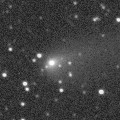
|
Now it is 13.1 mag (May 5, Chris Wyatt). It keeps 13 mag for a while. It is observable in excellent condition in the Southern Hemisphere. But it locates somewhat low in the Northern Hemisphere.
Date(TT) R.A. (2000) Decl. Delta r Elong. m1 Best Time(A, h)
May 21 15 35.06 -23 12.6 1.358 2.368 175 13.5 23:36 ( 0, 32)
May 28 15 29.71 -23 2.7 1.386 2.387 168 13.7 23:04 ( 0, 32)
|
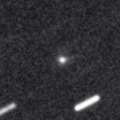
|
Now it is 14.6 mag (May 11, Hiroshi Abe). It will be observable at 14 mag in good condition from spring to summer.
Date(TT) R.A. (2000) Decl. Delta r Elong. m1 Best Time(A, h)
May 21 20 58.61 -11 43.9 1.946 2.433 106 14.3 3:12 (325, 36)
May 28 21 4.34 -11 22.8 1.875 2.438 111 14.2 3:06 (329, 38)
|

|
It is not observable now. It will be observable at 16.5 mag in September in the Northern Hemisphere, or in November in the Southern Hemisphere.
Date(TT) R.A. (2000) Decl. Delta r Elong. m1 Best Time(A, h)
May 21 4 58.38 17 17.3 2.945 1.992 15 14.3 20:41 (119, -9)
May 28 5 15.79 17 49.1 2.957 1.986 13 14.2 20:48 (122,-12)
|

|
Now it is 15.1 mag (Jan. 2, Ken-ichi Kadota). Distant object, but it keeps observable at 14-15 mag for a long time from 2015 to 2016.
Date(TT) R.A. (2000) Decl. Delta r Elong. m1 Best Time(A, h)
May 21 0 11.91 1 20.1 5.362 4.883 56 14.5 3:12 (277, 12)
May 28 0 17.50 1 39.2 5.273 4.883 62 14.5 3:06 (279, 15)
|
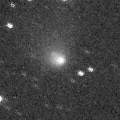
|
Now it is bright as 13.0 mag (May 6, Marco Goiato). It is observable at 14 mag in good condition from winter to summer.
Date(TT) R.A. (2000) Decl. Delta r Elong. m1 Best Time(A, h)
May 21 12 32.09 -16 24.1 1.531 2.338 132 14.8 20:41 ( 2, 38)
May 28 12 30.75 -17 9.6 1.596 2.340 125 14.9 20:48 ( 13, 37)
|
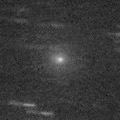
|
Now it is bright as 13.1 mag (May 4, Seiichi Yoshida). Although it was faint as 19.0 mag in January (Jan. 10, B. Lutkenhoner), it brightened rapidly in February. It will fade out rapidly after this. It keeps observable until May in the Northern Hemisphere, or until July in the Southern Hemisphere. But it keeps extremely low.
Date(TT) R.A. (2000) Decl. Delta r Elong. m1 Best Time(A, h)
May 21 6 29.01 16 50.7 2.013 1.355 37 15.0 20:41 (105, 8)
May 28 6 54.83 16 10.4 2.069 1.398 36 15.3 20:48 (106, 6)
|

|
Now it is 15.9 mag (May 4, Hidetaka Sato), brighter than originally predicted. It will brighten up to 14 mag in summer. In the Southern Hemisphere, it keeps observable until winter, but it locates somewhat low. In the Northern Hemisphere, it is not observable now. It will appear in the morning sky in July, then it will be observable in excellent condition.
Date(TT) R.A. (2000) Decl. Delta r Elong. m1 Best Time(A, h)
May 21 1 18.75 -9 25.6 1.980 1.503 47 15.3 3:12 (276, -8)
May 28 1 39.33 -6 49.6 1.942 1.480 48 15.0 3:06 (274, -6)
|
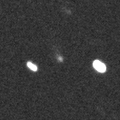
|
Now it is bright as 14.9 mag (May 4, Hidetaka Sato). It keeps 15 mag for a long time until 2016 autumn. In the Southern Hemisphere, it keeps observable for a long time. It will be unobservable after this in the Northern Hemisphere.
Date(TT) R.A. (2000) Decl. Delta r Elong. m1 Best Time(A, h)
May 21 5 0.32 -35 11.1 2.696 2.319 57 15.1 20:41 ( 69,-38)
May 28 5 13.76 -36 37.2 2.654 2.309 59 15.1 20:48 ( 69,-42)
|

|
It will brighten up to 13 mag in summer. But it keeps unobservable for a long time. It will appear in the morning sky in December, when the comet will be fainter than 15 mag.
Date(TT) R.A. (2000) Decl. Delta r Elong. m1 Best Time(A, h)
May 21 4 51.44 17 53.2 2.939 1.974 14 15.3 20:41 (120,-10)
May 28 5 8.89 18 4.4 2.890 1.911 11 15.1 20:48 (123,-13)
|
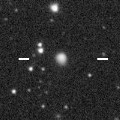
|
Now it is 15.4 mag (May 17, H. Boussier). It is expected to brighten up to 7 mag in 2017 summer. In the Northern Hemisphere, it keeps observable in good condition until the highlight while the comet will be brightening. In the Southern Hemisphere, it is not observable until early 2017.
Date(TT) R.A. (2000) Decl. Delta r Elong. m1 Best Time(A, h)
May 21 7 23.58 57 37.5 5.280 4.749 53 15.4 20:41 (140, 35)
May 28 7 32.41 57 9.6 5.274 4.685 49 15.3 20:48 (141, 31)
|

|
Now it is 16.3 mag (May 12, Yasukazu Ikari). It will brighten up to 14 mag in 2017. In 2016, it keeps observable at 16 mag in good condition from winter to spring. The perihelion distance increases from 2.4 a.u. to 2.9 a.u. in this apparition, and the comet will not brighten as before.
Date(TT) R.A. (2000) Decl. Delta r Elong. m1 Best Time(A, h)
May 21 11 21.05 14 0.4 3.324 3.720 105 16.3 20:41 ( 45, 63)
May 28 11 22.35 13 29.9 3.407 3.704 99 16.3 20:48 ( 56, 57)
|
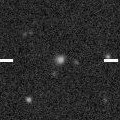
|
Now it is 16.4 mag (May 7, K. Sarneczky). The cometary activity is confirmed recently. It is expected to brighten up to 7 mag in 2017 spring. But it locates somewhat low at the high light.
Date(TT) R.A. (2000) Decl. Delta r Elong. m1 Best Time(A, h)
May 21 11 6.28 -0 27.9 4.270 4.677 107 16.4 20:41 ( 36, 48)
May 28 11 6.11 -0 16.1 4.309 4.607 100 16.3 20:48 ( 47, 44)
|
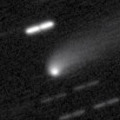
|
It brightened very rapidly in 2015 spring, and reached up to 13.8 mag (May 11, Sandor Szabo). It is bright as 14.4 mag still now (May 12, Yasukazu Ikari). It is observable in excellent condition in the Southern Hemisphere. But it locates somewhat low in the Northern Hemisphere.
Date(TT) R.A. (2000) Decl. Delta r Elong. m1 Best Time(A, h)
May 21 13 43.79 -27 39.0 3.312 4.218 149 16.3 21:46 ( 0, 27)
May 28 13 41.93 -27 8.4 3.387 4.246 143 16.4 21:16 ( 0, 28)
|

|
It brightened up to 3.7 mag and became a naked eye comet in mid January in 2015 (Jan. 13, Marek Biely). Now it is fading. It has already faded down to 16.0 mag (May 7, Yuji Ohshima). In the Northern Hemisphere, it keeps observable for a long time until the comet fades out. It locates somewhat low in the Southern Hemisphere.
Date(TT) R.A. (2000) Decl. Delta r Elong. m1 Best Time(A, h)
May 21 18 9.57 27 0.1 5.090 5.694 122 16.4 2:15 ( 0, 82)
May 28 18 4.34 27 1.8 5.111 5.757 125 16.4 1:42 ( 0, 82)
|
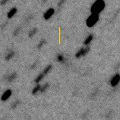
|
Now it is 15.1 mag (May 12, Yuji Ohshima). It will brighten up to 16 mag from April to May. It is observable in excellent condition in the Southern Hemisphere. It locates somewhat low in the Northern Hemisphere.
Date(TT) R.A. (2000) Decl. Delta r Elong. m1 Best Time(A, h)
May 21 15 8.83 -36 20.4 1.062 2.046 161 16.6 23:10 ( 0, 18)
May 28 14 59.31 -37 40.0 1.089 2.057 156 16.7 22:33 ( 0, 17)
|

|
Now it is bright as 15.9 mag (Apr. 9, Hidetaka Sato). It keeps 16 mag for a long time from 2016 to 2017. In 2016, it is observable in excellent condition in the Southern Hemisphere, but it locates extremely low in the Northern Hemispehre.
Date(TT) R.A. (2000) Decl. Delta r Elong. m1 Best Time(A, h)
May 21 11 58.58 -36 3.6 3.013 3.710 126 16.8 20:41 ( 9, 18)
May 28 12 0.63 -34 16.3 3.037 3.678 122 16.7 20:48 ( 16, 19)
|
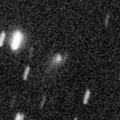
|
It brightened rapidly, and reached up to 15.5 mag (Feb. 11, Yasukazu Ikari). Now it is fading. It has already faded down to 16.5 mag (May 9, D. Buczynski). It keeps observable until August when the comet becomes fainter than 18 mag in the Northern Hemisphere. It will be unobservable soon in the Southern Hemisphere.
Date(TT) R.A. (2000) Decl. Delta r Elong. m1 Best Time(A, h)
May 21 8 43.09 41 38.1 2.786 2.515 64 16.7 20:41 (117, 44)
May 28 8 53.36 42 24.6 2.868 2.518 59 16.8 20:48 (119, 40)
|
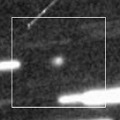
|
Now it is 17.2 mag (May 8, Space Surveillance Telescope, Atom Site). It will be observable at 13 mag for a long time from 2017 to 2018. In 2016, it keeps observable at 16-17 mag in good condition until autumn.
Date(TT) R.A. (2000) Decl. Delta r Elong. m1 Best Time(A, h)
May 21 20 14.88 -12 48.4 5.993 6.514 116 16.8 3:12 (338, 40)
May 28 20 11.16 -12 28.6 5.845 6.471 124 16.7 3:06 (346, 41)
|

|
It brightened up to 15 mag from late 2014 to early 2016. Now it is fading slowly. In the Northern Hemisphere, it will be observable at 17 mag in autumn in good condition. It locates extremely low in the Southern Hemisphere.
Date(TT) R.A. (2000) Decl. Delta r Elong. m1 Best Time(A, h)
May 21 0 24.03 31 11.5 5.322 4.701 47 16.9 3:12 (248, 25)
May 28 0 23.72 32 22.6 5.264 4.727 53 16.9 3:06 (249, 30)
|
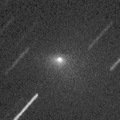
|
First return of an object discovered as an asteroid 2007 VA85 in 2007. It brightened very rapidly since mid February, and brightened up to 11.3 mag in spring (Mar. 5, Juan Jose Gonzalez). In the Northern Hemisphere, it locates extremely low in May, but it will be observable in the morning sky after June. However, it may fade out very rapidly and may be fainter than 18 mag. It keeps unobservable until September in the Southern Hemisphere.
Date(TT) R.A. (2000) Decl. Delta r Elong. m1 Best Time(A, h)
May 21 2 58.94 43 50.6 2.118 1.289 26 16.9 3:12 (220, 7)
May 28 2 55.08 45 25.6 2.121 1.338 29 18.3 3:06 (222, 11)
|
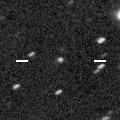
|
Now it is 16.9 mag (May 7, K. Sarneczky). It brightened rapidly, and became brighter than originally expected. It keeps 17 mag until 2017. It is observable in excellent condition in the Northern Hemisphere. It is not observable in the Southern Hemisphere.
Date(TT) R.A. (2000) Decl. Delta r Elong. m1 Best Time(A, h)
May 21 14 26.23 74 45.9 7.327 7.293 84 17.2 22:26 (180, 50)
May 28 14 7.89 74 9.1 7.361 7.290 82 17.2 21:40 (180, 51)
|

|
It brightened up to 13-14 mag from 2014 to 2015. Now it is fading. It has already faded down to 18.1 mag (Apr. 23, Slooh.com Canary Islands Observatory). It will be observable at 17 mag in 2016.
Date(TT) R.A. (2000) Decl. Delta r Elong. m1 Best Time(A, h)
May 21 23 12.88 -3 25.5 5.246 5.032 72 17.2 3:12 (290, 21)
May 28 23 16.43 -3 9.9 5.185 5.074 78 17.2 3:06 (293, 24)
|

|
It was observed as bright as 13-14 mag for a long time from 2011 to 2014. Now it is fading. It is observable in excellent condition in the Southern Hemisphere. It locates extremely low in the Northern Hemisphere. No observations have been reported since August, 2015.
Date(TT) R.A. (2000) Decl. Delta r Elong. m1 Best Time(A, h)
May 21 17 50.56 -36 10.5 8.571 9.457 149 17.3 1:56 ( 0, 19)
May 28 17 46.05 -36 27.7 8.556 9.491 156 17.3 1:24 ( 0, 19)
|

|
Now it is 16.8 mag (May 10, Catalina Sky Survey). It keeps observable at 17 mag in good condition from winter to spring.
Date(TT) R.A. (2000) Decl. Delta r Elong. m1 Best Time(A, h)
May 21 14 37.16 2 21.3 1.761 2.691 150 17.3 22:39 ( 0, 57)
May 28 14 33.00 1 39.1 1.813 2.707 145 17.4 22:07 ( 0, 57)
|

|
Now it is 19.3 mag (May 4, Hidetaka Sato). It will brighten up to 16.5 mag in summer and will be observable in good condition.
Date(TT) R.A. (2000) Decl. Delta r Elong. m1 Best Time(A, h)
May 21 18 19.23 -14 26.0 2.042 2.925 144 17.5 2:25 ( 0, 41)
May 28 18 16.17 -13 50.8 1.971 2.902 151 17.4 1:54 ( 0, 41)
|
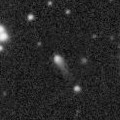
|
Now it is 16.5 mag (May 11, D. Buczynski). It keeps 17 mag from 2016 to 2017. It is observable in good condition in the Northern Hemisphere. In the Southern Hemisphere, it locates low in 2016, and it is not observable in 2017.
Date(TT) R.A. (2000) Decl. Delta r Elong. m1 Best Time(A, h)
May 21 17 13.14 31 38.0 5.769 6.399 124 17.4 1:18 ( 0, 87)
May 28 17 9.01 32 34.2 5.757 6.389 124 17.4 0:47 ( 0, 88)
|

|
It brightened up to 11-12 mag in 2012. It has already faded down to 18.3 mag (May 1, J. Oey, P. Camilleri, H. Williams). It is observable at 17 mag in good condition from winter to spring.
Date(TT) R.A. (2000) Decl. Delta r Elong. m1 Best Time(A, h)
May 21 10 21.38 -2 21.0 11.284 11.464 97 17.4 20:41 ( 48, 41)
May 28 10 20.77 -2 10.8 11.440 11.502 90 17.4 20:48 ( 57, 35)
|
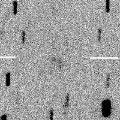
|
New comet. Now it is bright as 15.6 mag (May 6, Hidetaka Sato). It goes away from the earth rapidly, and it will be fainter than 18 mag in June.
Date(TT) R.A. (2000) Decl. Delta r Elong. m1 Best Time(A, h)
May 21 10 8.89 -3 57.1 1.165 1.612 95 17.4 20:41 ( 50, 38)
May 28 10 10.84 2 14.3 1.352 1.647 87 17.8 20:48 ( 63, 37)
|

|
First return of a new periodic comet which brightened up to 16.5 mag in 2008. The condition of this apparition is very good. It is expected to brighten up to 15.5 mag in autumn and will be observable in good condition.
Date(TT) R.A. (2000) Decl. Delta r Elong. m1 Best Time(A, h)
May 21 23 32.95 -24 9.4 2.684 2.648 77 17.6 3:12 (303, 4)
May 28 23 42.00 -23 18.2 2.583 2.625 81 17.4 3:06 (304, 6)
|
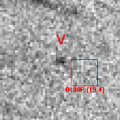
|
It is expected to brighten up to 16 mag and observable in good condition in autumn. However, it is so faint as 19.7 mag now (Apr. 16, A. Maury, J.-B. de Vanssay, J.-G. Bosch, J.-F. Soulier).
Date(TT) R.A. (2000) Decl. Delta r Elong. m1 Best Time(A, h)
May 21 22 47.94 -15 5.7 3.097 3.131 82 17.6 3:12 (304, 18)
May 28 22 54.30 -14 28.6 2.980 3.107 87 17.5 3:06 (306, 21)
|
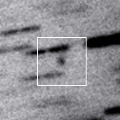
|
Now it is 18.0 mag (Apr. 12, A. Maury, J.-B. de Vanssay, J.-G. Bosch, J.-F. Soulier). It keeps observable at 17.5 mag in good condition from spring to autumn in the Southern Hemisphere. It is not observable in the Northern Hemisphere.
Date(TT) R.A. (2000) Decl. Delta r Elong. m1 Best Time(A, h)
May 21 18 15.81 -63 35.2 4.332 5.046 130 17.7 2:22 ( 0, -9)
May 28 18 12.52 -63 59.4 4.285 5.037 133 17.7 1:51 ( 0, -9)
|

|
Very far object. Outburst occured on Feb. 20, 2015, and it brightened up to 15 mag. Now it is 16.7 mag (Apr. 4, Hidetaka Sato). It is observable in excellent condition in the Southern Hemisphere. It locates somewhat low in the Northern Hemisphere.
Date(TT) R.A. (2000) Decl. Delta r Elong. m1 Best Time(A, h)
May 21 13 12.71 -23 48.3 8.355 9.184 143 17.7 21:15 ( 0, 31)
May 28 13 11.73 -23 28.7 8.424 9.187 136 17.8 20:48 ( 1, 31)
|

|
Although it was bright as 17 mag at the discovery in 2006, it faded out before the perihelion passage in 2008, and it became lost. Now it is fainter than 22 mag (June 15, 2015, Erwin Schwab, Marco Micheli).
Date(TT) R.A. (2000) Decl. Delta r Elong. m1 Best Time(A, h)
May 21 15 45.29 6 36.7 3.562 4.488 153 17.8 23:47 ( 0, 62)
May 28 15 41.31 6 36.9 3.573 4.482 150 17.8 23:15 ( 0, 62)
|
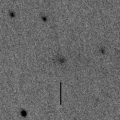
|
Now it is 16.8 mag (Apr. 12, Hidetaka Sato). It was expected to brighten up to 14 mag from winter to summer. But it is much fainter actually. It will be observable in excellent condition in the Southern Hemisphere. It locates low in the Northern Hemisphere.
Date(TT) R.A. (2000) Decl. Delta r Elong. m1 Best Time(A, h)
May 21 16 25.37 -39 35.4 1.677 2.648 159 17.8 0:31 ( 0, 15)
May 28 16 20.50 -39 56.4 1.709 2.690 161 17.9 23:54 ( 0, 15)
|

|
It brightened up to 11.1 mag in 2015 autumn (Sept. 21, Seiichi Yoshida). Now it is 17.6 mag (Apr. 29, D. Buczynski). It keeps observable in good condition after this, while the comet will be fading gradually.
Date(TT) R.A. (2000) Decl. Delta r Elong. m1 Best Time(A, h)
May 21 11 15.55 11 11.1 2.621 3.047 105 17.8 20:41 ( 43, 59)
May 28 11 18.32 10 32.9 2.762 3.093 99 18.0 20:48 ( 54, 54)
|
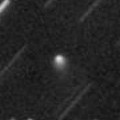
|
Now it is 16.4 mag (May 10, Catalina Sky Survey). It becomes brighter than at the discovery in 2015. It is observable at 17 mag in good condition from spring to summer.
Date(TT) R.A. (2000) Decl. Delta r Elong. m1 Best Time(A, h)
May 21 14 51.67 4 22.1 5.578 6.484 151 17.8 22:53 ( 0, 59)
May 28 14 47.88 5 10.0 5.648 6.504 145 17.9 22:22 ( 0, 60)
|
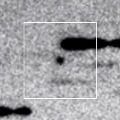
|
It keeps 16 mag for a long time from 2017 to 2018. Now it is 17.8 mag (May 13, J. Oey, P. Camilleri, H. Williams). In the Southern Hemisphere, it keeps observable in good condition until early summer. It will be unobservable in May in the Northern Hemispehre.
Date(TT) R.A. (2000) Decl. Delta r Elong. m1 Best Time(A, h)
May 21 8 55.66 -19 58.4 6.698 6.677 84 17.9 20:41 ( 53, 14)
May 28 8 56.53 -18 59.3 6.770 6.647 78 17.9 20:48 ( 60, 9)
|

|
Now it is 18.3 mag (May 8, A. Diepvens). In the Northern Hemisphere, it keeps observable in good condition after this while the comet will be fading. It locates low in the Southern Hemisphere.
Date(TT) R.A. (2000) Decl. Delta r Elong. m1 Best Time(A, h)
May 21 13 8.36 27 24.6 2.908 3.501 118 17.9 21:10 ( 0, 82)
May 28 13 5.73 26 20.3 3.022 3.542 112 18.0 20:48 ( 12, 81)
|
|
![]()
 29P/Schwassmann-Wachmann 1
29P/Schwassmann-Wachmann 1 116P/Wild 4
116P/Wild 4 53P/Van Biesbroeck
53P/Van Biesbroeck 118P/Shoemaker-Levy 4
118P/Shoemaker-Levy 4 C/2011 KP36 ( Spacewatch )
C/2011 KP36 ( Spacewatch ) 77P/Longmore
77P/Longmore 104P/Kowal 2
104P/Kowal 2 146P/Shoemaker-LINEAR
146P/Shoemaker-LINEAR C/2015 T4 ( PanSTARRS )
C/2015 T4 ( PanSTARRS ) C/2015 TQ209 ( LINEAR )
C/2015 TQ209 ( LINEAR ) C/2015 V2 ( Johnson )
C/2015 V2 ( Johnson ) 65P/Gunn
65P/Gunn C/2015 ER61 ( PanSTARRS )
C/2015 ER61 ( PanSTARRS ) C/2014 W11 ( PanSTARRS )
C/2014 W11 ( PanSTARRS ) C/2014 Q2 ( Lovejoy )
C/2014 Q2 ( Lovejoy ) 100P/Hartley 1
100P/Hartley 1 C/2016 B1 ( NEOWISE )
C/2016 B1 ( NEOWISE ) C/2015 Y1 ( LINEAR )
C/2015 Y1 ( LINEAR ) C/2015 O1 ( PanSTARRS )
C/2015 O1 ( PanSTARRS ) C/2014 A4 ( SONEAR )
C/2014 A4 ( SONEAR ) 333P/LINEAR
333P/LINEAR C/2014 R3 ( PanSTARRS )
C/2014 R3 ( PanSTARRS ) C/2012 F3 ( PanSTARRS )
C/2012 F3 ( PanSTARRS ) C/2010 S1 ( LINEAR )
C/2010 S1 ( LINEAR ) 180P/NEAT
180P/NEAT 219P/LINEAR
219P/LINEAR C/2014 OE4 ( PanSTARRS )
C/2014 OE4 ( PanSTARRS ) C/2006 S3 ( LONEOS )
C/2006 S3 ( LONEOS ) C/2016 J2 ( Denneau )
C/2016 J2 ( Denneau ) P/2008 J3 ( McNaught )
P/2008 J3 ( McNaught ) 188P/LINEAR-Mueller
188P/LINEAR-Mueller C/2015 H2 ( PanSTARRS )
C/2015 H2 ( PanSTARRS ) C/2013 C2 ( Tenagra )
C/2013 C2 ( Tenagra ) P/2006 F1 ( Kowalski )
P/2006 F1 ( Kowalski ) C/2014 Y1 ( PanSTARRS )
C/2014 Y1 ( PanSTARRS ) 67P/Churyumov-Gerasimenko
67P/Churyumov-Gerasimenko C/2015 LC2 ( PanSTARRS )
C/2015 LC2 ( PanSTARRS ) C/2016 A1 ( PanSTARRS )
C/2016 A1 ( PanSTARRS ) 19P/Borrelly
19P/Borrelly![]()










































